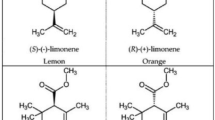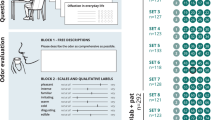Abstract
An odor perception is the brain's interpretation of the activation pattern of many peripheral sensory neurons that are differentially sensitive to a wide variety of odors. The sensitivity of these neurons is determined by which of the thousand or so odor receptor proteins they express on their surface. Understanding the odor code thus requires mapping the receptive range of odorant receptors. We have adopted a pharmacological approach that uses a large and diverse pool of odorous compounds to characterize the molecular receptive field of an odor receptor. We found a high specificity for certain molecular features, but high tolerance for others—a strategy that enables the olfactory apparatus to be both highly discriminating, and able to recognize several thousand odorous compounds.
This is a preview of subscription content, access via your institution
Access options
Subscribe to this journal
Receive 12 print issues and online access
$259.00 per year
only $21.58 per issue
Buy this article
- Purchase on SpringerLink
- Instant access to full article PDF
Prices may be subject to local taxes which are calculated during checkout





Similar content being viewed by others
References
Beets, M. G. J. Structure-Activity Relationship in Human Chemoreception (Applied Science, London, 1978).
Mori, K., Nagao, H. & Yoshihara, Y. The olfactory bulb: coding and processing of odor molecule information. Science 286, 711–715 (1999).
Buck, L. & Axel, R. A novel multigene family may encode odorant receptors: a molecular basis for odor recognition. Cell 65, 175–187 (1991).
Mombaerts, P. Seven transmembrane proteins as odorant and chemosensory receptors. Science 286, 707–711 (1999).
Zhao, H. et al. Functional expression of a mammalian odorant receptor. Science 279, 327–242 (1998).
Malnic, B., Hirono, J., Sato, T. & Buck, L. B. Combinatorial receptor codes for odors. Cell 96, 713–723 (1999).
Rubin, B. D. & Katz, L. C. Optical imaging of odorant representations in the mammalian olfactory bulb. Neuron 23, 499–511 (1999).
Duchamp-Viret, P., Chaput, M. A. & Duchamp, A. Odor response properties of rat olfactory receptor neurons. Science 284, 2171–2174 (1999).
Bozza, T. C. & Kauer, J. S. Odorant response properties of convergent olfactory receptor neurons. J. Neurosci. 18, 4560–4569 (1998).
Touhara, K. et al. Functional identification and reconstitution of an odorant receptor in single olfactory neurons. Proc. Natl. Acad. Sci. USA 96, 4040–4045 (1999).
Krautwurst, D., Yau, K. W. & Reed, R. R. Identification of ligands for olfactory receptors by functional expression of a receptor library. Cell 95, 917–926 (1998).
Wetzel, C. H. et al. Specificity and sensitivity of a human olfactory receptor functionally expressed in human embryonic kidney 293 cells and Xenopus laevis oocytes. J. Neurosci. 19, 7426–7433 (1999).
Marriott, D. P., Dougall, I. G., Meghani, P., Liu, Y. J. & Flower, D. R. Lead generation using pharmacophore mapping and three-dimensional database searching: application to muscarinic M(3) receptor antagonists. J. Med. Chem. 42, 3210–3216 (1999).
Bikker, J. A., Trumpp-Kallmeyer, S. & Humblet, C. G-protein coupled receptors: models, mutagenesis, and drug design. J. Med. Chem. 41, 2911–2927 (1998).
Zhao, H., Otaki, J. M. & Firestein, S. Adenovirus-mediated gene transfer in olfactory neurons in vivo. J. Neurobiol. 30, 521–530 (1996).
Mackay-Sim, A. & Kesteven, S. Topographic patterns of responsiveness to odorants in the rat olfactory epithelium. J. Neurophysiol. 71, 150–160 (1994).
Ottoson, D. Handbook of Sensory Physiology (Olfaction) (Springer, Berlin, 1971).
Serizawa, S. et al. Mutually exclusive expression of odorant receptor transgenes. Nat. Neurosci. 3, 687–693 (2000).
Shepard, G. M. in The Synaptic Organization of the Brain (ed. Shepard, G. M.) 159–204 (Oxford Univ. Press, New York, 1998).
Duchamp-Viret, P. & Duchamp, A. Odor processing in the frog olfactory system. Prog. Neurobiol. 53, 561–602 (1997).
Firestein, S., Picco, C. & Menini, A. The relation between stimulus and response in olfactory receptor cells of the tiger salamander. J. Physiol. (Lond.) 468, 1–10 (1993).
Singer, M. S. Analysis of the molecular basis for octanal interactions in the expressed rat I7 olfactory receptor. Chem. Senses 25, 155–165 (2000).
Pilpel, Y. & Lancet, D. The variable and conserved interfaces of modeled olfactory receptor proteins. Protein Sci. 8, 969–977 (1999).
Hashimoto, M. et al. A neural cell-type-specific expression system using recombinant adenovirus vectors. Hum. Gene Ther. 7, 149–158 (1996).
Kanegae, Y., Makimura, M. & Saito, I. A simple and efficient method for purification of infectious recombinant adenovirus. Jpn. J. Med. Sci. Biol. 47 157–166 (1994).
Niwa, H., Yamamura, K. & Miyazaki, J. Efficient selection for high-expression transfectants with a novel eukaryotic vector. Gene 108, 193–200 (1991).
Yuste, R., Lanni, F. & Konnerth, A. (eds.). Imaging Neurons: A Laboratory Manual (Cold Spring Harbor Laboratory Press, New York, 2000>).
Mohamadi, F. et al. MacroModel—an integrated software system for modeling organic and bioorganic molecules using molecular mechanics. J. Comput. Chem. 11, 440–467 (1990).
Acknowledgements
We thank T. Loggia and C. Zhang for their assistance with the virus preparation and animal infection, X. Zhang for his help with the Ca2+ imaging experiments, C. Margot and Firminch for chemicals and discussion, B. Schilling and Givaudan-Roure (Vernier, Switzerland) for chemicals, Takasago (Kanagawa, Japan) for neral and geranial, and P. Mombaerts for comments. This work was supported by the Whitehall and McKnight Foundations and the NIDCD.
Author information
Authors and Affiliations
Corresponding author
Rights and permissions
About this article
Cite this article
Araneda, R., Kini, A. & Firestein, S. The molecular receptive range of an odorant receptor. Nat Neurosci 3, 1248–1255 (2000). https://doi.org/10.1038/81774
Received:
Accepted:
Issue date:
DOI: https://doi.org/10.1038/81774
This article is cited by
-
Influence of elongation and desaturation on chemosensory properties in acrylates and their corresponding 1-alken-3-ones
Analytical and Bioanalytical Chemistry (2022)
-
The role of the odorant receptors in the formation of the sensory map
BMC Biology (2021)
-
Insights into a receptor that lets insects sense scents
Nature (2021)
-
Odor coding in the mammalian olfactory epithelium
Cell and Tissue Research (2021)
-
Imputation of sensory properties using deep learning
Journal of Computer-Aided Molecular Design (2021)



